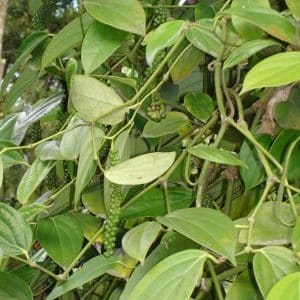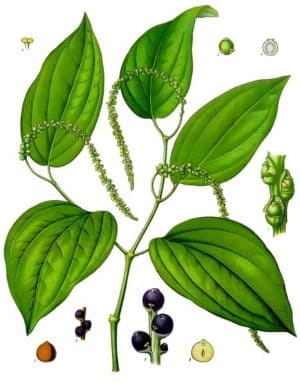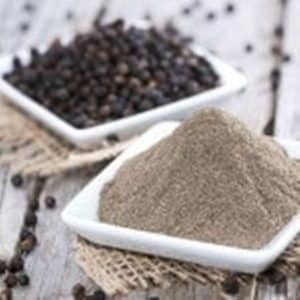How black pepper grows, its benefits and harms, areas of application
In the Middle Ages, black pepper, when it was already widespread in Europe, served as a spice, a medicine, an exchange coin, a means of investment, and simply a gift among wealthy people. They were paid dues, paid bribes and fines.
Today for us it is just a spice that is in every kitchen. We pepper our dishes without hesitation. What is pepper? What are its properties? how it grows how is it useful and harmful? It turns out that hot seasoning can not only improve the taste of dishes. Read more below.
Black pepper
Piper, or as everyone knows it, pepper is one of the oldest crops. The history of cultivation of black pepper goes back more than four thousand years in its historical homeland in the state of Kerala (formerly Malikhabar, translated as “land of pepper”) on the southwestern coast of India.
This narrow coastal strip is home to the climbing shrub, the fruit of which is the famous black pepper.
Interesting. Peas were called “black gold”, they were an item of trade and could be used as money. In Germany, wealthy people were called “pepper bags.”
Black peppercorns were used in the mummification of pharaohs, as evidenced by excavations of the tomb of Ramses II (1213 BC). Then the use of peas in cosmetology began.
Today, the world leader in seasoning production is Vietnam.

Pepper is a species of the Pepper genus of the Pepper family (Piperaceae).It is a shrub or small vine-like tree, reaching a length of up to 15 meters in natural habitats. True, on plantations its height is no more than 5-6 meters. Aerial roots form at the nodes.

Science knows up to one and a half thousand species, but only six of them are used as seasoning: African, Long, Black and White Piper and Cubeba. Most species grow in the tropics - in America and the monsoon regions of East Asia.
The fruit of the plant is round and pea-shaped, 3-5 mm in diameter. Initially it is green in color, as it ripens it turns red, and when it dries it turns black. Pepper cobs reach a length of 8-14 cm, each brush contains about 20-30 fruits.
Previously, pharmacies used peas as a weight when weighing goods. If the fruits are of high quality, then 1000 peas weigh exactly 460 g.
They are spread mainly by birds and small mammals, such as bats.

The leaves are simple, ovate, leathery, alternate, 80-100 mm long. It blooms with small white or gray-yellow flowers collected in inflorescences.

It bears fruit twice a year for 25-30 years, starting in the fourth year. Bred only for the sake of obtaining fruits.
Botanical illustration from a book, 1887
Chemical composition and properties
 Today, the spice is widespread and grown on plantations from America to Asia.
Today, the spice is widespread and grown on plantations from America to Asia.
Compound:
- resin (1-2%);
- fatty oil (6-12%);
- oleoresin – used as a food additive in industrial food production;
- alkaloid piperine (5-9%), which gives hotness to peppers of the genus Piper;
- essential oil (0.9-2.5%). This is responsible for the familiar smell of pepper. The composition of the essential oil includes dipentene, phellandrene, sesquiterpene, caryophyllene;
- starch (up to 60% - depending on the type).
Nutritional value per 100 g of product:
- carbohydrates - 64 g (21% of a person’s daily value);
- fats - 3.26 g (4%);
- proteins - 10.39 g (14%);
- water - 12.46 g;
- ash - 9.89 g.
Calorie content - 256 kcal per 100 g.
Compound:
- sugars - 0.6 g;
- fiber - 25.3 g;
- cholesterol - 0 mg;
- trans fats - 0 g.
Among the fat-soluble substances present in black pepper are: vitamins A, beta-carotene, alpha-carotene, E and K.
Water-soluble vitamins B1, B2, B3 (PP), B4, B5, B6 and B9:
- vitamin A - 27 mcg (3% of the human daily requirement);
- beta-carotene - 310 mcg (6.2%);
- alpha-carotene - 12 mcg (0.2%);
- vitamin E - 1 mg (7.1%);
- vitamin K - 163.7 mcg (136.4%);
- vitamin B1 - 0.1 mg (9.0%);
- vitamin B2 - 0.2 mg (13.8%);
- vitamin B3 - 1.1 mg (7.1%);
- vitamin B4 - 11.3 mg (2.3%);
- vitamin B5 - 1.4 mg (28.0%);
- vitamin B6 - 0.3 mg (22.4%);
- vitamin B9 - 17 mcg (4.3%).
The ratio of minerals (macro- and microelements) contained in black pepper:
- calcium - 443 mg (44.3% of the human daily requirement);
- iron - 9.7 mg (97.1%);
- magnesium - 171 mg (42.8%);
- phosphorus - 158 mg (22.6%);
- potassium - 329 mg (28.3%);
- sodium - 20 mg (1.5%);
- zinc - 1.2 mg (10.8%);
- copper - 1.3 mg (147.8%);
- manganese - 12.8 mg (554.5%);
- selenium - 4.9 mcg (8.9%);
- fluorine - 34.2 mcg.
Benefit
Spices are attributed many useful properties: antiseptic, antioxidant, antibacterial, carminative, antimicrobial, analgesic, antispasmodic, tonic, warming, diuretic and choleretic.
The following positive characteristics are highlighted:
- For the cardiovascular system: improves blood circulation, preventing blood clots.
- For the respiratory system: when combined with honey, it helps remove mucus from the lungs.
- For the digestive system: removes toxins, waste and parasites from the body, is beneficial for liver function, stimulates the production of enzymes to improve metabolism.
- For the nervous system: a natural antioxidant, stimulates the production of joy hormones endorphin and serotonin.
Black pepper may be beneficial:
- in case of blood circulation disorders;
- in the absence of appetite;
- with insufficient secretion of gastric juice;
- for colic, constipation, weak intestinal motility;
- as a diuretic;
- for arthrosis, rheumatism, arthritis;
- with ARVI;
- for sprains and muscle pain;
- for the treatment of herpes;
- to strengthen the immune system;
- for the treatment of migraines, weakness and dizziness;
- to activate the work of the spleen;
- for blood thinning;
- for dermatitis;
- to eliminate toothache;
- for diseases of the oral cavity;
- with excess weight;
- like an aphrodisiac.
Harm
The harm of Piper lies only in its pungency, which can cause harm to the body. But for this you need to eat more than 4 g of pepper per day.
You should limit your consumption of black pepper if you have any medical conditions:
- gastric mucosa (gastritis, ulcer);
- for hypertension;
- in case of serious pathologies of the kidneys and bladder;
- for mental disorders;
- pregnancy.
Uses of black pepper
Pepper is usually added to dishes and taken on the chest when there are signs of a cold. However, there are many more ways to use it.
In cooking
The spice is mainly used for culinary purposes. Black pepper is added to all dishes: soups, main courses, sausages, confectionery, cold appetizers.
Experienced chefs also use the white spice in cooking, adding it to creamy sauces, white meat and fish dishes.
Green Piper is a favorite herb in Asian cuisine, although it is now becoming more common in Europe. It also goes well with sauces, seafood, and meat.
Interesting. An unusual use of the Malikhabar berry is in desserts and cookies, and adding it to cocktails, teas and coffee will give the drinks a tonic effect and an unusual taste.
In Russia, black pepper is common both in peas and ground. Its shelf life is unlimited under sealed storage conditions. But the shelf life of ground is limited to a month, after which it loses its pungency and spiciness. Therefore, spice mills are relevant and in demand, allowing you to grind pepper during cooking.
In folk medicine
The use of pepper in folk medicine has been practiced for a long time. It is used to make tinctures, inhalations, rinses and rubs.
Important! Follow the dosage - the slightest excess of the permissible portions can cause discomfort and side effects.
Anti-cough
Piper helps thin mucus. To make coughing easier, take two small pinches of the ground product (on the tip of a knife), mix thoroughly with four tablespoons of honey and add a few drops of lemon juice. Take this remedy three times a day.
Against colds
In case of ARVI, you should eat two peas four times a day.
For diarrhea
For intestinal disorders, it is recommended to drink 1 tbsp. l. baked milk with black pepper on the tip of a knife.
For constipation
Hot seasoning stimulates intestinal motility.
To do this, it is recommended to take half a teaspoon of pepper and a pinch of cinnamon, dilute it in a glass of boiling water, and leave for half an hour. Then drink one sip for an hour. The spasms subside, the functioning of the digestive system normalizes.
In the treatment of respiratory organs (respiratory diseases)
Brew milk with black spice and turmeric, drink in small sips.
For joint pain and rheumatism
For rubbing: 1 glass of olive oil, two tablespoons of pepper. Heat in a water bath for about 15 minutes. Cool to room temperature. Rub into sore spots.
Pepper patch helps a lot. To do this, mix one teaspoon each of pepper, honey and flour. Apply to the sore spot, cover with gauze and secure with a bandage.
For the treatment of impotence
Mix 0.25 tsp. hot spices and 0.25 tsp. Sahara. You will get half a teaspoon of the mixture. Dilute it in a glass of milk and drink. Repeat for seven days.
For diabetes
People suffering from diabetes are susceptible to thrombosis, and the hot seasoning thins the blood. The product speeds up metabolism, its glycemic index is low - only 15 units, there will be no harm from it. But you need to know when to stop - the maximum dose is only 1 g per day.
For weight loss
The fat-burning property of the seasoning allows you to lose weight during physical inactivity. It enhances intestinal motility and promotes rapid cleansing of toxins and prevents new fat deposition.
To do this, it is useful to make a drink from the juice of cucumbers (100 ml), bell peppers (50 ml) and tomatoes (50 ml), adding a pinch of ground spice.
For kidney stones
This remedy will help dissolve sand or remove stones: put black peas inside the raisins. Once a day before lunch, take five of these peas for two weeks.
For skin diseases
Mix seasoning and henna in equal proportions. Apply to damaged areas once daily.
This remedy will help against lichen, eczema, boils, and urticaria.If you grind black grains into dust, then mix them with yogurt, you can get rid of freckles and pimples.
In cosmetology and perfumery
Since pepper began to be used in the mummification of pharaohs, science has advanced greatly.
Interesting. The spice can improve skin tone and even out its color. Creams with pepper berry extract have antiseptic and antibacterial properties, which helps problematic skin.
Using the seasoning in combination with other hair ingredients helps strengthen hair follicles, awaken dormant follicles, and make hair thicker and stronger.
Mask for the face
Helps cleanse the skin of acne and pimples, accelerates the regeneration of epidermal cells. For external use.
To do this, mix pepper and cottage cheese in equal proportions until smooth. Apply to face with massage, circular movements. Rinse off after 15 minutes with cool water. With regular use, skin color evens out and inflammation goes away.
Hair Mask
For hair loss, mix salt, pepper powder and onion juice in equal proportions. Apply to hair for 45 minutes along the entire length. Rub into scalp. Wash off with natural shampoo. The effect will be noticeable with regular use for the fourth time.
Compresses for puffiness under the eyes
“Bags” under the eyes are a problem in modern society. The fast pace of life, constant stress and lack of sleep are the causes of edema.
Mix half a teaspoon of ground coffee and the same amount of coconut oil. Add the Malikhabar berry on the tip of a knife. Dilute with water to the consistency of thick sour cream. Apply the mixture to the swelling for 10 minutes - carefully so as not to get into your eyes. Rinse off with a damp cotton swab and wash with cool water.
The compress will improve the condition of the skin under the lower eyelids.
Contraindications
The benefits and harms of black pepper depend on whether there are any strict contraindications to its use. In moderate quantities, the product will help get rid of the symptoms of many diseases and strengthen the body. People with hypertension, gastrointestinal diseases, and throat diseases should not abuse it.
How to grow black pepper at home

It is possible to grow the spice at home. Let's take a closer look at what you should pay attention to.
Varieties
For growing you will have to look for red black pepper seeds. They are sold in sealed cellophane bags.
It is believed that any variety of seeds that are sold in the grocery store in the seasoning section can germinate. Experiment.
Only large black peas will germinate, so choose high-quality products that are dried without violating technology or using chemicals that increase shelf life.
Pay attention to what is written on the packaging: how it was dried seeds, whether in a natural way.

Peas that were packed more than a year ago will most likely not germinate., so look for fresher seeds.
Before planting, soak them in warm water (+25 °C) for a day. Throw away any that float.
Landing
The seeds should be planted in a pot with a drainage layer of expanded clay or ordinary crushed stone. A ready-made mixture is suitable for planting. Planted in late May - early June.
The container with the planting is placed on western or eastern windows, where there is no direct sunlight, but there is enough lighting. If this is not possible, on the south side you will have to shelter the plant from bright light.
Pepper feels good at a temperature of +25 °C.At +16 °C, a period of rest and wintering begins.
To start sprouting, you should cover it with film - for a greenhouse effect and create a climate similar to a tropical one. Ventilate and water the plants regularly. Shoots should appear in 3-4 weeks.
Care
The soil should be slightly moist. In autumn, watering is reduced by half.
Fertilize with complex mineral fertilizer or chicken manure. This is done twice a year: before growth begins (in spring) and after fruiting (in autumn).
Replant as necessary in the spring. Young plants are replanted every year, using larger-volume planting containers, and adults - once every two years.
Problems you may encounter during the growing process:
- the plant stretches out or sheds its leaves - lack of sunlight;
- leaves are brown - not enough moisture; if they turn yellow - excessive moisture;
- under good growing conditions, the plant reaches a height of up to two meters - then it will need support.
During cultivation, you can notice white formations resembling eggs on the back of the leaf. Over time they will turn black. These formations are a feature of plants; they do not pose any danger.

Harvest and storage
The spice begins to bear fruit in the second year of growth. Depending on the time of harvesting the fruits, green, white and black pepper are obtained. White is obtained by soaking ripe fruits for two weeks and then peeling and drying.
It is best to store in a tightly closed glass jar. Grind in small portions before use.
Conclusion
In order for the Malikhabar berry to reach the table in its usual form, the harvest is still unripe, green or yellow.Harvesting sometimes takes many months as the seeds ripen unevenly, so the process is considered labor intensive.
Seasoning lovers don't have to go to the store to buy pepper. You can plant it on your windowsill. You now know the rules and secrets of growing. With good care, you will have your own spicy harvest in two to three years.